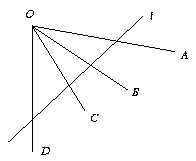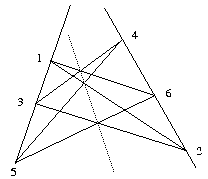Prove that f has two fixed points, p, q equidistant from f(∞).
If x ≠ p, q is a point in RP1, prove that the cross-ratios ( p , q ; x , f(x) ) = ( p , q ; f(x) , x ) and deduce that these are -1.
[Hint: Show first that one can map [α, 0, 0], [0, β, 0] and [0, 0, γ] to three of the points. Then choose α, β, γ so that [1, 1, 1] is mapped to the fourth point.]
 of the set { ∞, 0, 1 }.
of the set { ∞, 0, 1 }. If a, b, c are any distinct points of RP1, describe how to find a projective transformation of order 3 which maps a to b and b to c.
Show that the matrix
 with a ≠ 0 represents an element Ta of PGL(2, R) which has ∞ as a unique fixed point and that restricted to the affine part of RP1 it represents a translation by a.
with a ≠ 0 represents an element Ta of PGL(2, R) which has ∞ as a unique fixed point and that restricted to the affine part of RP1 it represents a translation by a.Prove that any projective map with a single fixed point is conjugate to a map of the form Ta for some a.

If a line l meets the pencil OA, OB, OC, OD as shown, show that the cross-ratio of the four points of intersection does not depend on which line l we take.
If the vertices of a hexagon lie alternately on two lines, then the meets of opposite sides are collinear.
[Hint: Project two of the meets to points on the line at infinity.]
